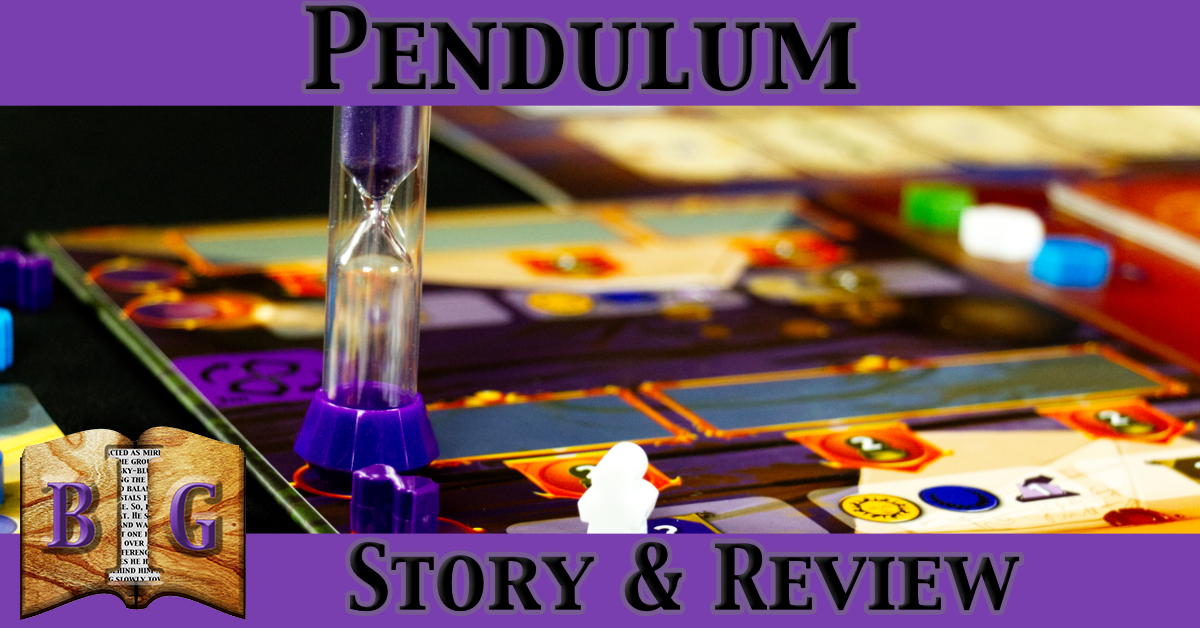Note: I was provided a complimentary copy of Pendulum for the purpose of review. The thoughts and opinions in this review are my own.
At a Glance: Pendulum
Year Published: 2020
Designer: Travis P. Jones
Publisher: Stonemaier Games
Artists: Robert Leask
Player Count: 1-5
Editor: N/A
Suggested Age: 12+
Playing Time: 60-90 minutes
Theme: Fantasy
Mechanisms: Worker placement, real time, variable player powers
Find more about Pendulum by visiting Stonemaier Games online on Facebook and Instagram, and their website!
“Time is a valuable thing
Watch it fly by as the pendulum swings
Watch it count down to the end of the day
The clock ticks life away
It’s so unreal.”
― Linkin Park, In The End
Pendulum Intro Story: Story Title
Time was running short.
With the Timeless King gone, a new ruler needed to be selected. The only problem was, Bolk didn’t have a mind for politics. War was simple. Lead an army, capture a province, and gain its resources for his own gain. But politics? That involved words that meant multiple different things, depending on who you were talking to. Bolk could conquer all the provinces he wanted, but without the backing of the bigwigs, that extra land wouldn’t do much good. And time was certainly running out.
Bolk looked at his map of the realm, looking for any weakness he could exploit that would help his cause, rather than sitting in conference, politicking with the other wannabe leaders. But it was no use. He needed to be political. He needed the votes. And, so, off he went to the council, ready to make a case for himself.
He was late, of course. If he had to attend, then he would be remembered, for good or ill. The room quieted as he entered, and all heads turned in his direction. The looks on their faces weren’t of fear that he’d finally arrived, or awe at his presence. Instead, they all had indifferent looks plastered to their faces.
Something snapped inside Bolk. The outrage at being treated like a lesser being would not go unpunished. He would sit in council, he would listen to the lies of the others, and he would present his own lies.
But there would be recompense. All these others would suffer for their apathy toward him, the rightful ruler of the realm. He sat and sneered, a small hint of his rage that they would feel soon enough. The time to act had come, and there was no turning back.
Time was running short.
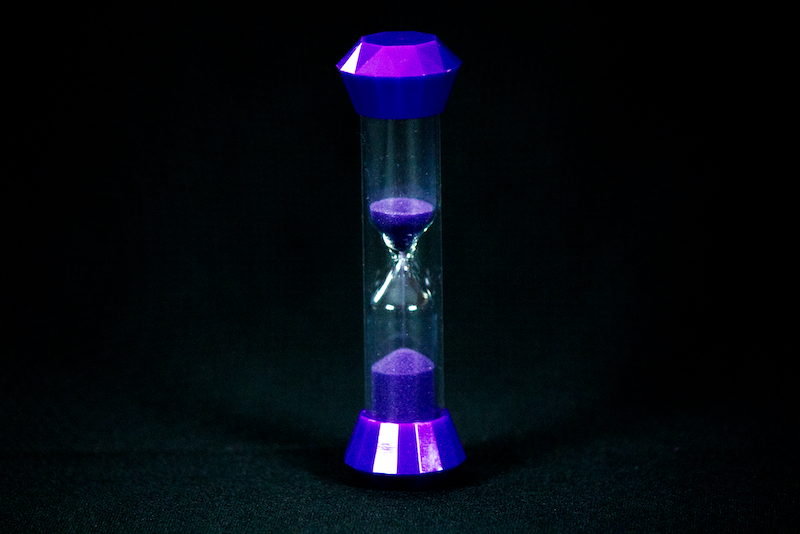
Overview/Roadmap
This review has two parts. First, there is the Short Review, where various aspects of the game are discussed. Then comes the Gameplay Review, in which the setup and gameplay are discussed in detail, along with initial thoughts. Following the Gameplay Review section are some final thoughts and a final verdict of the game. Feel free to jump around, or read it all in one go.
Pendulum: Short Review
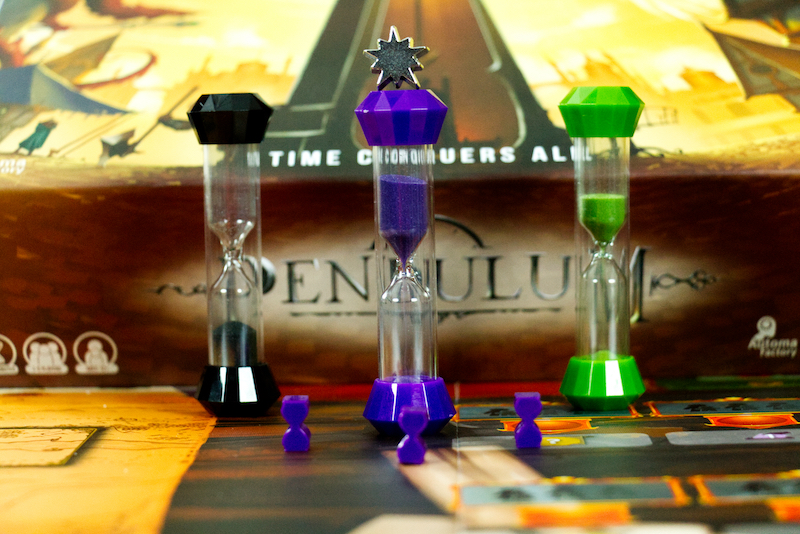
Pendulum is a real-time, worker-placement game for 1-5 players. The real-time aspect adds a unique twist on worker placement, and the timers control where they can or can’t be placed, as well as when their actions can happen. As a huge fan of real-time games, I’m quite pleased with Pendulum. The rounds feel like they zoom by (thanks, real time!), but it’s not a constant stress fest either. There’s a nice balance of real-time placement and chances to catch your breath. And, if you’re not into real-time, there’s an option to play without the clock ticking down.
Immersion

I feel like there’s a strong immersion factor in Pendulum. I mean, it’s real time, so if you’re not invested in the gameplay, you’re not going to do well at all. While the timers practically force immersion, the other mechanisms work well with the theme to provide fun gameplay with a good amount of choices.
The theme itself is about using time to conquer a nation, and it is represented well through the art. The fantasy theme lends itself well to a variety of characters, with humans to dragons.
Theme
I feel like there’s a strong immersion factor in Pendulum. I mean, it’s real time, so if you’re not invested in the gameplay, you’re not going to do well. While the timers practically force immersion, the other mechanisms work well with the theme to provide fun gameplay with a good amount of choices.
The theme itself is about using time to conquer a nation, and it is represented well through the art. The fantasy theme lends itself well to a variety of characters, with humans to dragons and…other things.
Art & Components
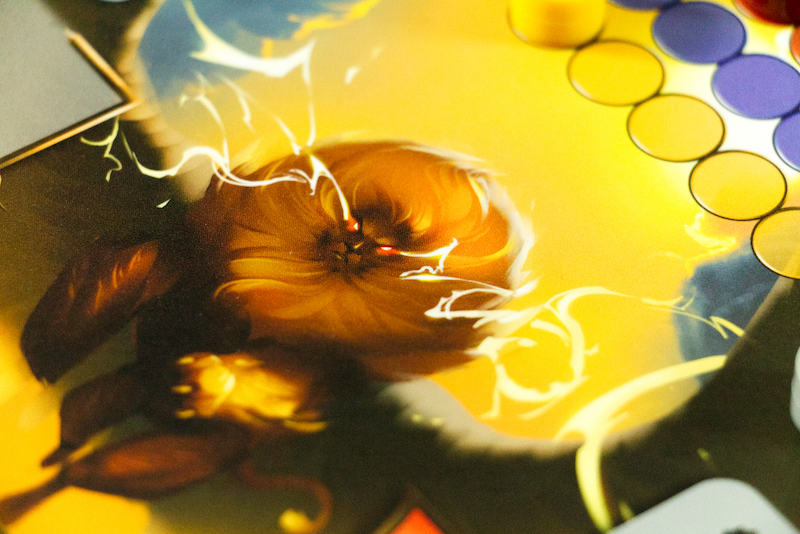
I feel like I could cut and paste my comments about components for all Stonemaier games—the components are the good quality you know and love from them. There are quite a few cards as well, and while they’re nothing to write home about as far as quality, they’re certainly not bad. Good quality all around.
The art is pretty neat, and the player boards especially help bring the world and characters to life. I find that art in fantasy games can really make a setting, and we are fortunate to have an engaging art style attached to Pendulum.
Standout Performances
- Neat take on the real-time mechanism
- Impressive solo variant, especially considering the real-time nature of the game
- Rounds feel quick
- Rounds are broken up with a chance to think and regroup
- No waiting for your turn
Breaking the 4th Wall
In theater, breaking the fourth wall refers to when characters (or something else) directly address the audience, thus pulling them out of the narrative and making them astutely aware that they are, in fact, watching a performance and that’s it’s not actually real.
A lot of times, we as board gamers buy games, play them a couple of times, and then shelve them as we acquire more games, play them a few times, and so forth. While this isn’t obviously true for everyone, a lot of gamers tend to buy, play, and shelve. With Pendulum, it can take some getting used to when playing in real time. Because of that, it’s not the kind of game you’ll want to shelve for prolonged periods of time and then hope to get in a quick game a year or so down the road. Due to the real-time nature of the game, if the rules aren’t fresh, you might struggle. Of course, this isn’t a flaw in the game itself, but rather something to be aware of.
Learning the game can feel intense, especially if you use timers for every round. However, it is recommended that you go timerless for the first round or two in order to be comfortable with the gameplay while the timers are running, which I also strongly suggest.
The timers themselves seem a little unstable, and it can be easy to knock them over in your haste to flip them. Not a big deal (and it hasn’t been much of an issue for me, personally), but I see the potential for toppled timers.
Pendulum Gameplay Review
First Impressions
The first time I played Pendulum, I wasn’t sure what was going on. We even played untimed, but my brain simply was not having it. However, as the rounds progressed, I quickly began to understand the flow of the game and how it all came together. Perhaps it was too late for my first game, but subsequent games were easier and, might I add, more enjoyable.
Setup

Setup is relatively painless. Each player gets 10 of each resource token and then everything else in their player color. Players are given the four Stratagem cards that correspond with their character, and they gain starting resources as stated on their character board. The timers are placed on their spot at the top row of each section (black, green, and purple), the first reward cards are revealed, and the other cards are placed on the board in their respective spot. All in all, it’s actually a relatively quick setup, which is wonderful.
Pendulum Gameplay

The core mechanism of Pendulum revolves around worker placement; however, the use of timers makes things quite different than other worker-placement games you may be used to. The main thing to remember is that the placement of the timers dictates where your workers can be placed/removed and when you can take a space’s action.
There are three timers: 45 seconds, 2 minutes, and 3 minutes. There are also three worker-placement sections, each one correlating with one of the timers. The times are placed next to a row of actions in their designated section, and the game starts with all timers being flipped to the other (identical) row in their section. As timers run out, players flip them to the other row in their section, opening up new worker spots and allowing workers to take actions.
You see, the timers dictate what you can do. If a row does not have a timer, workers can be placed on (and removed from) any top worker spot in that row. If the timer is at a specific row with workers previously placed, those workers may then move down to the reward area of the worker spot, thereby activating the space and giving resources/province cards/etc.
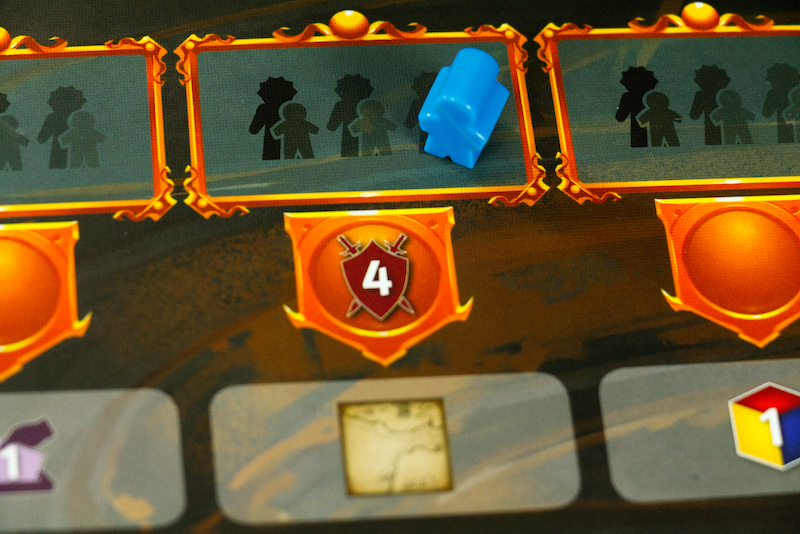
So there’s this flip-flopping method of placement and actions players must balance in order to increase each of their score tracks. That’s how you win the game—get all four of your score tracks from one side of the parchment to the other. There are three tracks that each have worker spots to help you move them up, and a fourth track that has only one space to move. However, this “legendary” point can only be gained once per round, and only by one player. To earn it, you must have resources in the amount shown on the legendary award card. As long as you’re the first to place your reward token on that card, you may claim the token and gain the point. If the token is already taken—or if you already got it or don’t want it—there is an optional reward you can claim instead, usually in the form of points or resources. But you can only claim one reward (the point or the resources), not both.
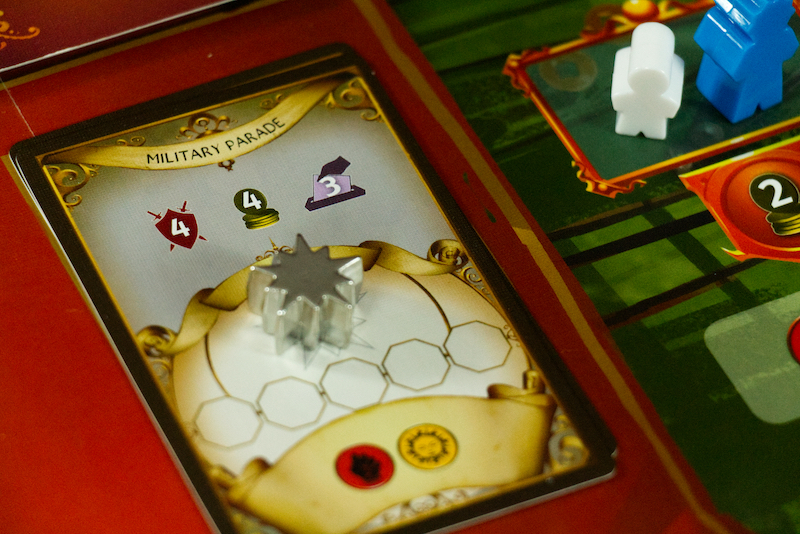
One the three-minute (purple) timer has flipped four times (including the flip to start the game), the end of the round is triggered and players keep playing and placing, but no longer flipping timers. Once everyone has done what they need to (or can do), the Council phase starts. The Council phase reorganizes player position based on votes, grants players the ability to move up any score track they want—twice for the player on top), gain reward cards, and then set up for the next round.
At the end of the game, once four rounds have been played, a winner is decided. The winner is the player who has moved all four of their score markers to the parchment side of their score tracks. If multiple people have done so (or if nobody has), then there are tie breakers to still see a winner crowned.
Thoughts on Gameplay

The more I play Pendulum, the more I like it. It’s feels fast paced, but it’s not as frantic as a lot of other real-time games (looking at you, FUSE). The symbology isn’t too tough to grasp, but it’s certainly easier to learn by not using the timers. Fortunately, the designer included a timer track to use instead of the actual timers. This way, players are able to weigh their options without stressing about the sand grains falling through the hourglasses. Needless to say, jumping into Pendulum for the first time by playing in real time is probably not the best idea. That said, after a round or two without timers, you should be ready to play with them from then on out.
As I mentioned above, this isn’t one of those games you can dust off every couple of years to sit down for a quick game. If you are not savvy on the rules and icons, it might feel like you’re learning it for the first time. While that’s not necessarily a bad thing, it can make it difficult to get to the table as often as you’d like, especially if it’s been a while and you don’t have time to re-learn the game. Small issue, but one I can see happening to many of us if we’re not careful.
Solo Play
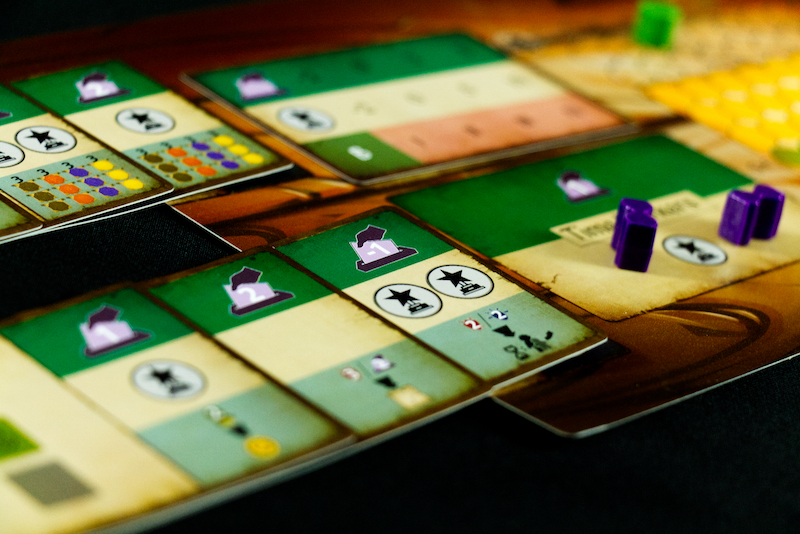
The solo variant of Pendulum is actually really good. I mean, all of Stonemaier’s games have great solo gameplay, so I shouldn’t be surprised. But the simulation of two other players is pretty solid, and the automa cards provide a fairly realistic method of simulating where those AI players place their workers. It’s a challenge for sure, but there are multiple difficulty levels as well, which I always enjoy, since I prefer playing against challenging AI opponents. The automas’ rules are simple and don’t require a lot of movement on the players’s part, which is ideal, since this is a real-time game and I sure don’t want to waste my precious time moving the AI workers and keeping score for them. All in all, it’s a solid solo variant and one I’ll definitely get out for a quick solo fix.
Pendulum Final Thoughts
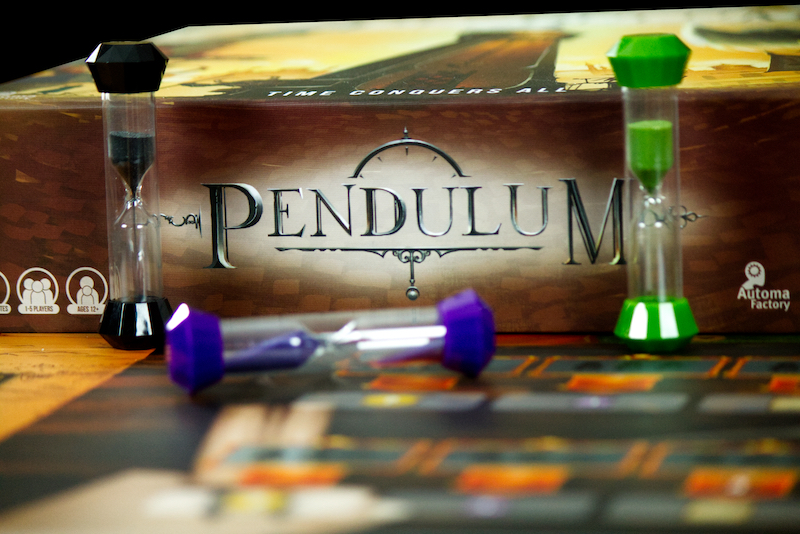
Pendulum is a good, solid game. I daresay it may be my least favorite of Stonemaier’s games, but I still really enjoy it and, the more I play, the more I find I like it. Much like certain foods, I think Pendulum might be an acquired taste for some. My wife, who is not a huge real-time fan, enjoys the game and is grateful it’s not as hectic as one of her least-favorite games, FUSE (I, on the other hand, love FUSE). Pendulum manages to balance the worker-placement and real-time mechanisms so that it’s not overwhelming for players who don’t enjoy those particular mechanisms. Honestly, I find the game is much more enjoyable with the timers, as it provides a lot more depth to the game, but there’s always the alternative of no timers that’s what helps you sleep at night.
Final Verdict
I find I give most games from Stonemaier Games a pretty good rating (pretty good for me, anyway). I find all of their games to be a lot of fun without too complicated rules. So how does Pendulum fall into the rankings? Like I mentioned, it’s probably bottom tier for me (as far as Stonemaier Games games are concerned), but it’s still pretty dang good. Thus, my ranking for Pendulum is a solid Two Thumbs Up. The marriage to the two main mechanisms is unique and tightly knit together, allowing for engaging gameplay, with or without timers.
Like This, Like That
This section is here to help you compare this game with other games you may be familiar with.
Pendulum has two core mechanisms: real-time and worker placement. Fans of either mechanism may very well enjoy Pendulum. Fans of games like Flatline (real-time) and Champions of Midgard (worker placement) might consider giving Pendulum a closer look.
Verdict Scale (Lowest to Highest)
The Final Verdict is based on a scale of 1-7, although this scale is not numbered. Instead, it uses thematically appropriate words to describe the performance of the game.
Tomatoes – This game was emotionally taxing and difficult to finish.
Uninspiring – This game had me daydreaming about other games.
Lackluster – This game had its moments, but it probably won’t see much table time.
Laodicean – This game is decent. It works. There’s a reason people like it.
Two Thumbs Up – This game is pretty dang good.
Captivating – This game is outstanding! It’s more than good; it’s practically a staple.
Standing Ovation – This is the best game you will ever play. Period.
Read short fiction inspired by board games at BGI’s stories page!
Visit Stonemaier Games on Facebook, Instagram, Twitter, and at their website.

